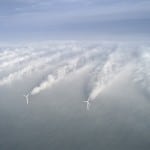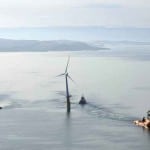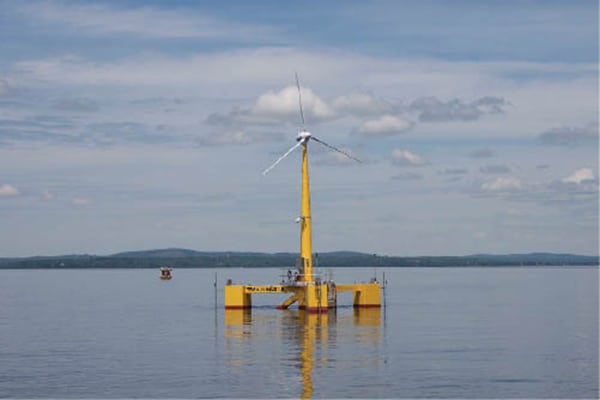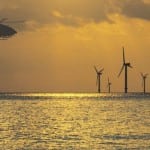One of the first concrete-composite floating platform wind turbines in the U.S. was last week deployed off the coast of Castine, Maine. The project’s launch, led by the University of Maine (UMaine), is a milestone for a nation whose 4,000 GW of offshore wind energy potential lies in deep water—but has no grid-connected commercial offshore wind farms yet.
The Energy Department supported the project with a $12 million investment over five years. UMaine and its project partners conducted extensive design, engineering, and testing of floating offshore wind turbines over five years that culminated in the construction and deployment of the 65-foot-tall “VolturnUS” prototype.
The prototype is one-eighth the size of a 6-MW, 423-foot rotor diameter turbine design envisioned for commercial installation. The project is expected to collect data to validate and improve floating wind turbine designs, while helping address technical barriers to greater offshore wind cost reductions, the DOE said in a statement on May 31.
One way the University of Maine’s design could reduce overall costs is by using advanced materials. It features, for example, a unique semi-submersible platform that uses a lower cost concrete foundation in addition to a lighter weight composite tower. As part of the five-year project, the Maine Maritime Academy helped test and conduct analysis on these pioneering designs, while Pittsfield, Maine-based Cianbro Corp. leveraged its experience in maritime energy infrastructure and ship building to construct this first-of-its-kind wind energy system, UMaine said.
Meanwhile, a larger offshore wind demonstration—dubbed "Aqua Ventus I"—that would feature the full-scale turbine design is in the works, slated to be connected to the grid by 2016. That project is one of seven offshore wind design and engineering projects announced last year by the DOE. The DOE said it is still currently conducting the engineering and design phase, but it intends to select up to three projects for additional funding in 2014 to support construction and installation.
Collaborative research and development on the VolturnUS prototype was conducted by the UMaine-led DeepCwind Consortium, a public-private partnership funded by the DOE, the National Science Foundation, the Maine Technology Institute, the state of Maine, UMaine, and more than 30 industry partners.
The much-watched Cape Wind offshore wind project under development in Nantucket Sound, Mass., could break ground this year after more than a decade of delays. Former Interior Secretary Ken Salazar was widely quoted this April as expressing optimism about the $2.6 billion project because it had secured agreements with utilities to purchase about 75% of its produced power.
The 130-turbine project, the first offshore wind farm in the U.S. to obtain a federal lease, has been delayed by a number of contentious lawsuits and financing hurdles. See POWER‘s coverage of the Cape Wind project.
Sources: POWERnews, UMaine, DOE, POWER
—Sonal Patel, Senior Writer (@POWERmagazine, @sonalcpatel)
NOTE: This story was originally published on June 4










